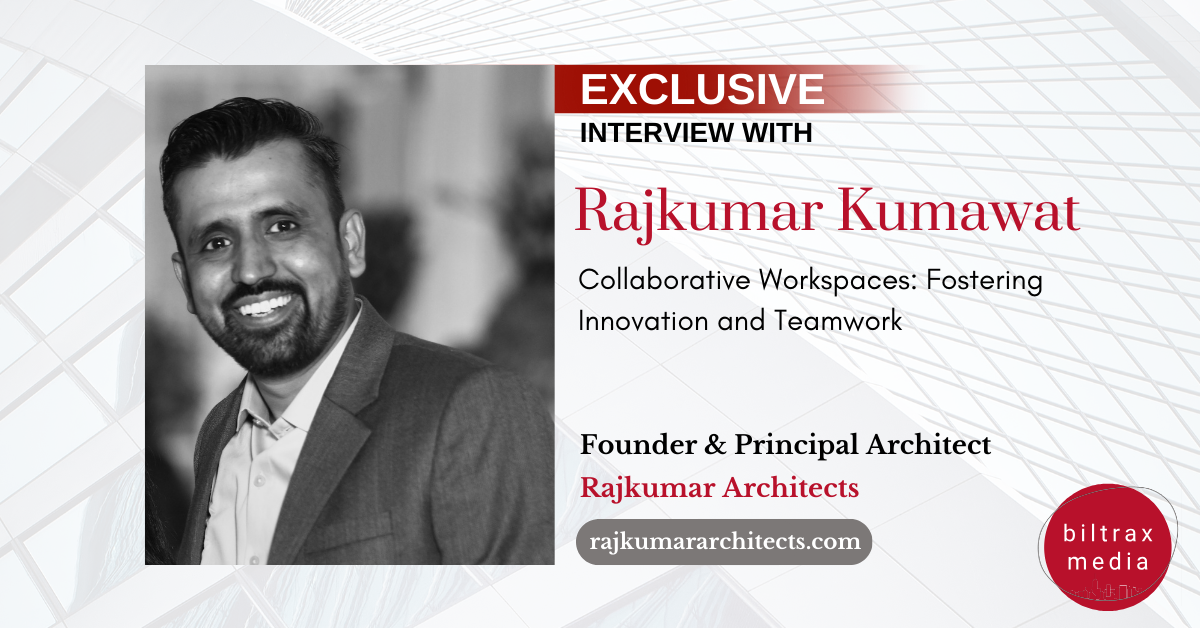In the landscape of contemporary workplaces, the traditional cubicle-centric model is giving way to collaborative workspaces that prioritize interaction, creativity, and collective problem-solving. This shift is not merely a trend, it reflects a fundamental understanding of the value the collaboration brings to organizational success. Keeping up with the context, Ar. Rajkumar Kumawat, Founder & Principal Architect at Rajkumar Architects explores the concept of collaborative workspaces and how they contribute to fostering innovation, enhancing teamwork and ultimately driving the overall efficiency and success of modern businesses.
Evolution of Collaborative Workspaces
The concept of collaborative workspaces represents a departure from the conventional office layout characterized by individual cubicles and closed-off offices. This evolution is a response to the changing nature of work, influenced by factors such as technological advancements, the rise of remote work, and a growing emphasis on employee well-being and satisfaction. One of the hallmarks of collaborative workspaces is the prevalence of open-floor plans. These layouts promote visibility, accessibility, and a sense of shared space, fostering spontaneous interactions among team members.

Collaborative workspaces often feature flexible seating arrangements, allowing employees to choose where they work based on their preferences. This flexibility enhances autonomy and contributes to a more dynamic work environment. Beyond workstations, these spaces incorporate dedicated zones for group activities which may include meeting rooms, breakout areas, and communal spaces designed to facilitate collaboration and idea exchange. For instance, our project GA Infra Office has an informal lounge and games area for the employees to relax while exploring new ideas. Additionally, tech integration can enable seamless communication and collaboration. Video conferencing, project management tools, and collaborative software platforms are crucial in connecting team members, even in geographically dispersed settings.


Enhancing Teamwork
Effective teamwork is a cornerstone of organizational success, and collaborative workspaces are designed to enhance communication, collaboration, and team cohesion. Collaborative workspaces leverage technology to establish efficient communication channels. Whether through video conferencing or project management tools, teams can stay connected in real-time, irrespective of physical location. Moreover, this breakdown of hierarchical barriers creates a more egalitarian environment where communication flows freely across levels and departments. Our project GA Infra Office incorporates flexible seating arrangements and shared spaces that contribute to a sense of ownership and collective responsibility where employees can take pride in their work and collaborate effectively.

Supporting Employee Well-Being
Collaborative workspaces prioritize employee well-being, recognizing the impact of the work environment on physical and mental health. These workspaces often incorporate elements of biophilic design, including ample natural light and indoor plants. Exposure to natural light and greenery has been linked to improved mood, productivity, and overall well-being. Further, incorporating ergonomic principles can create comfortable and user-friendly environments. Adjustable desks, supportive chairs, and proper lighting contribute to a workspace that promotes physical health. Innovation thrives in an atmosphere that encourages the cross-pollination of ideas.
In essence, the collaborative workspace is not just a trend, it is a strategic response to the evolving needs of the modern workforce and a key driver of success in the dynamic and competitive business landscape. They represent more than just a shift in office design as they signify how organizations view work, innovation, and employee well-being. As the business landscape continues to evolve, the importance of fostering a collaborative culture becomes increasingly evident. Collaborative workspaces have become integral to modern work culture, breaking down traditional barriers and nurturing innovation and teamwork. Through open layouts and shared environments, they facilitate spontaneous interactions and idea exchange, fostering a culture of creativity. Embracing this modern approach to workspaces is not just a trend but a strategic move for organizations aiming to thrive in an ever-changing business landscape.



Biltrax Construction Data is tracking 29,000+ projects on their technology platform for their clients.
Get exclusive access to upcoming projects in India with actionable insights and gain a competitive advantage for your products in the Indian Construction Market.
Visit www.biltrax.com or email us at contact@biltrax.com to become a subscriber and generate leads.
Disclaimer: The information contained herein has been compiled or arrived at, based upon information obtained in good faith from sources believed to be reliable. All such information and opinions can be subject to change. The image featured in this article is for representation purposes only and does not in any way represent the project. If you wish the article to be removed or edited, please email editor@biltrax.com.
Discover more from Biltrax Media, A Biltrax Group venture
Subscribe to get the latest posts sent to your email.






















